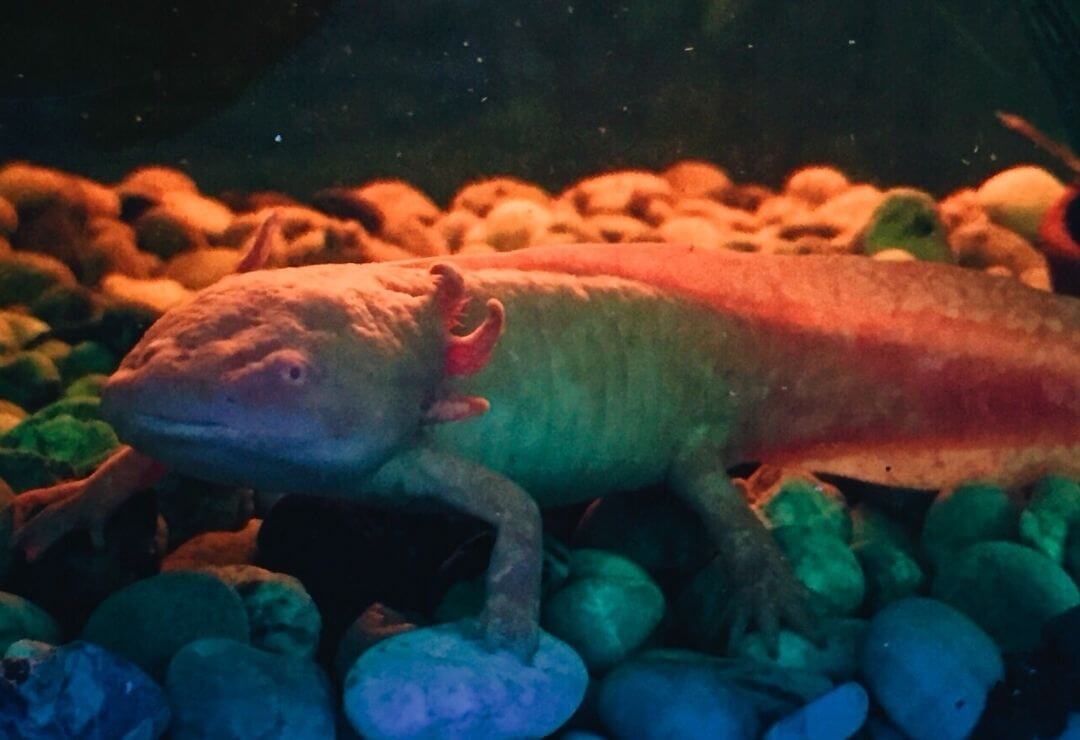Amphibian Metamorphosis

How Do Amphibians Metamorphosize?
Word of the Week
Larva
A larva is an organism in its immature phase that looks and acts very different from an adult of its species! When an amphibian exits its egg, it is typically in its larval form.
A tadpole is the larval form of a frog! Unlike adult frogs, tadpoles do not have legs and spend all of their time in water.
Amphibian Exceptions
Most amphibians go through a similar metamorphosis with complete phases. However, some amphibians are extra special and have skip their larval phase or even stay in their larval phase forever!
No Aquatic Larval Phase
- Most amphibians have four stages of metamorphosis.
- Some frogs lay their eggs on land and eggs hatch into froglets instead of tadpoles. These froglets live on land.
- Some species of salamanders skip most of the metamorphosis process. These species hatch from their eggs as tiny versions of the adult.
Example: Black Salamander
Stay in Aquatic Larval Phase
- Most amphibians only spend part of their lives as larva living in water, but some stay in their aquatic larval phase forever!
- They do grow legs, but never lose their gills or aquatic behaviors.
- This happens because some animals are not able to produce the hormones they need to complete the metamorphosis process.
Example: Axolotl
The Environment Plays a Role in Amphibian Metamorphosis!
Amphibian metamorphosis partially depends on their hormones.
Some environmental factors can cause amphibians to produce the hormone sooner and metamorphose faster!
Over-population, food shortages, drought, or other factors can force amphibians to reach their adult phase faster. This allows them to move onto land where there are different resources!
Species Spotlight
Axolotl
Ambystoma mexicanum
Axolotls are best known for being an amphibian that does not go through complete metamorphosis! They never turn into their terrestrial (land-dwelling) adult phase. Instead, they keep their long, paddle-like tails, webbed feet, and gills for their whole lives! They’re also known for having an incredible superpower; they can regrow their body parts if they get damaged. They can regenerate legs, tails, gills, and even their bones and eyes, which can help them survive more than 10 years in the wild.
Axolotls are a fairly large salamander, sometimes reaching more than 1 foot in length, that are only found in a small area near Mexico City. The lake in which they are found has been heavily drained and polluted, making it challenging for axolotls to survive. While they have become rare in the wild, axolotls are quite common as pets and are frequently bred in captivity. They are also studied by scientists to learn more about how they regenerate body parts and are an important part of Mexican culture.
BRAIN BLAST
Why do you think scientists are studying axolotl regeneration? Is there any way that information about how their regeneration works could be helpful to humans? Discuss!
Conservation Corner
Invasive Frogs
Nature has an incredible balance that allows native plants and animals to thrive in their environment. When non-native species are introduced to an area, they can throw off that balance and make it more challenging for native species to survive. The American bullfrog was once only found east of the Rocky Mountains but today, it can be found all across the United States and even in other countries.
American bullfrogs are quite large and very successful predators. They will eat anything they can fit in their mouth, including birds, fish, bats, and even other frogs! They also produce a large number of eggs, as many as 20,000 eggs each season, which has caused their populations to grow rapidly and outcompete native species.
Invasive species are a problem in many different ecosystems. We can help keep ecosystems balanced by not releasing non-native pets, cleaning our hiking shoes before hiking in new locations, and volunteering to remove invasive species.
Glossary
Adaptation
The process by which a species becomes more fit for its environment over the course of several generations. It is a result of natural selection.
Aquatic
Living in water.
Eft
The terrestrial larval phase of a salamander's life cycle.
Egg
An object laid by a female frog (and other species) that contains a developing embryo.
Environmental Factors
Any part of an ecosystem, living or nonliving, that impacts a living organism.
Froglet
The phase of a frog's life cycle when the tadpole is changing into an adult frog.
Gills
The respiratory organ that allows fish and crustaceans to absorb oxygen molecules from water.
Larva
The aquatic phase of an amphibian's life cycle occurring after the amphibian exits the egg.
Metamorphosis
The process of an animal changing and developing from an egg to an adult through different life phases.
Permeable
Allowing liquid, nutrients, or other chemicals to pass through.
Tadpole
The aquatic larval phase of a frog's life cycle.
Sign Up for our Newsletter
Stay up to date with new adventures, live classes, deals, and more!

Helpful Resources
*Please note we do not offer refunds for EdZOOcating Adventures memberships. We recommend you explore the 3-day free trial prior to subscribing!*






